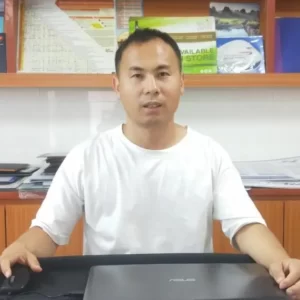In this video, we walk you through every step of making our blue yoga mat material: from coating the durable PU top to bonding the natural rubber yoga mats base for unbeatable grip.
Part 1: Manufacturing the raw sheet of PU yoga mat material layered over a Natural Rubber Non slip Base—the secret behind the best yoga mat (PU top + Natural Rubber Non slip Base) on the market.
Part 2: Cutting and finishing the raw sheets into full-size yoga mats, ready for your practice.
Why choose our mats?
- Eco friendly yoga mat: Made with sustainably sourced natural rubber and recyclable PU.
- Good to use and easy to clean. Simply wipe down after each session.
- Trusted yoga mat supplier for studios, gyms, and home practitioners worldwide.
Ready to upgrade your practice? Subscribe for more behind-the-scenes tours and discover why our mats are the top choice for yogis everywhere!
How to Clean Yoga Mat?
Here’s an easy, gentle routine to keep your PU-top, rubber-base yoga mat clean and long-lasting:
1. Daily or After-Use Wipe-Down
- Mix a spray bottle of warm water with a few drops of mild, pH-neutral dish soap (or gentle laundry detergent).
- Lightly mist the surface—don’t soak.
- Wipe with a soft microfiber or cotton cloth to remove sweat and surface dirt.
- Let air-dry flat or hang—avoid direct sun.
2. Weekly or Deep Clean
- Prepare Cleaning Solution
- In a clean tub or large basin, fill with lukewarm water and add about 1–2 teaspoons of mild soap.
- Soak and Gently Scrub
- Lay your mat flat in the water.
- Use a soft sponge or nonabrasive brush to lightly scrub both sides—focus on stained or sweaty spots.
- Rinse Thoroughly
- Lift the mat out and rinse under running water until no soap suds remain.
- Remove Excess Water
- Roll the mat up (like a sushi roll), pressing gently as you go to push out water.
- Air-Dry Completely
- Unroll and hang or lay flat in a well-ventilated area, away from direct sunlight or heaters. Only once fully dry should you roll it for storage.
3. Stain or Odor Removal
- For stubborn spots, make a paste of baking soda + water, apply lightly, scrub gently, then rinse.
- To neutralize odors, add 1–2 tablespoons of white vinegar to your wash water (it won’t leave a vinegar smell once rinsed).
4. Important Tips
- Never use bleach, strong cleaners, or machine-wash/dry—these damage the PU surface.
- Avoid leaving your mat rolled up when damp; this traps moisture and causes mold.
- Store rolled loosely or flat in a cool, dry place.
Following this routine will keep your PU-top rubber mat grippy, hygienic, and smelling fresh—so every practice feels clean and safe.
How to choose a yoga mat?
When selecting a yoga mat, consider these key factors to find one that supports your practice:
1. Material
- PU top + Natural rubber base
- Grip: PU (polyurethane) surfaces provide excellent “sticky” traction when you’re sweaty.
- Cushioning: Natural rubber underneath gives resilience and shock-absorption, protecting your joints.
- Durability & Eco-friendliness: Natural rubber is biodegradable, and PU wears well over time.
- Best Choice: A PU-top, natural-rubber-base mat delivers the ideal balance of grip, comfort, and sustainability.
- Other Options (for comparison)
- PVC (standard): Affordable, long-lasting, but less eco-friendly and can be slippery when wet.
- TPE: Lightweight and recyclable, but generally offers less grip and durability.
- Cotton or jute: Natural fibers, good for hot yoga, but thinner and less cushioning.
2. Thickness & Density
- Standard (3–5 mm): Good balance of firmness and cushioning—suitable for most styles.
- Thick (6 mm+): Extra padding for sensitive knees or joints; heavier and less stable for balance poses.
- Thin (1–2 mm): Lightweight and portable; offers less support but better ground feel.
3. Texture & Surface
- Smooth PU Surface: “Sticky” feel, clean wipe-down, great for precise alignment.
- Textured Rubber: Natural ridges add grip but can collect dirt in grooves—requires more frequent cleaning.
4. Size & Weight
- Length & Width: Make sure it’s at least as tall as you and about 60–70 cm wide for comfortable spacing.
- Portability: Heavier natural-rubber mats (2.5–4 kg) stay put during practice but can be bulky to carry; thinner PU mats weigh less.
5. Maintenance & Care
- Cleaning: PU-top rubber mats wipe down easily with a mild soap solution (see “How to clean…”).
- Drying: Always air-dry flat, away from direct sunlight to prevent cracking or fading.
6. Price & Warranty
- Mid-range to Premium: PU + natural rubber mats typically fall in the $60–$120 range but often include a warranty.
- Value: Investing a bit more generally means better long-term performance and less environmental impact.
Recommendation
For most practitioners—whether you flow, stretch, or hold long poses—a PU-top, natural-rubber-base mat is the best all-around choice. You’ll get superior grip when you sweat, enough cushion for your joints, and an eco-friendlier product that lasts.


